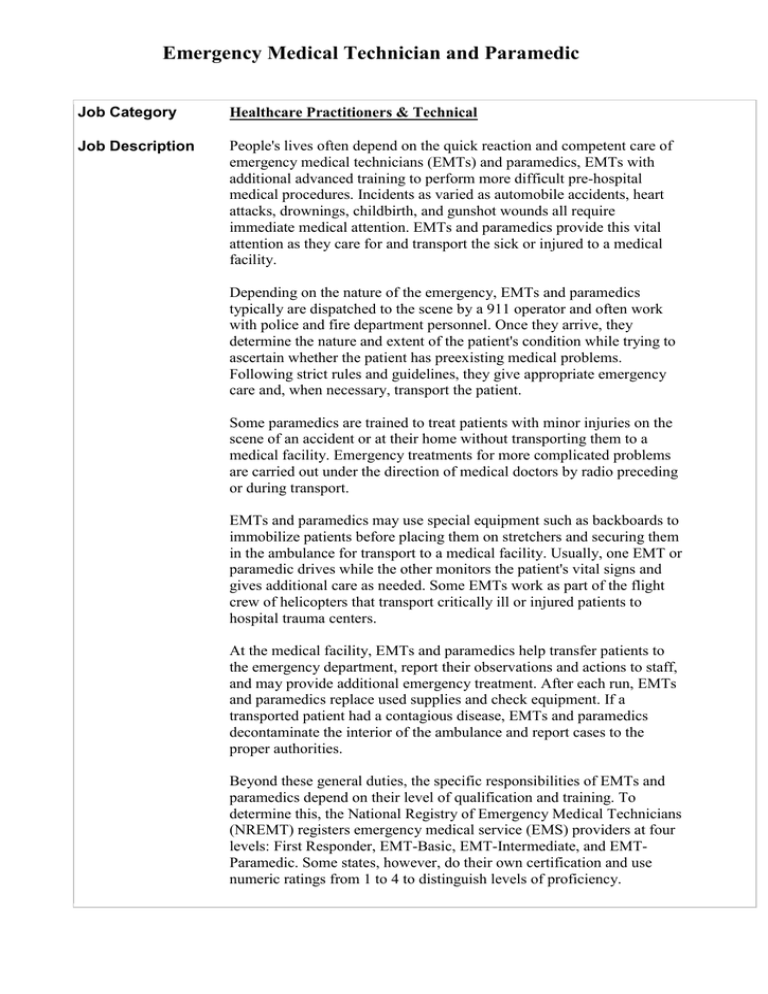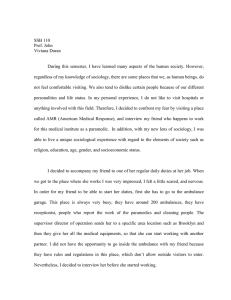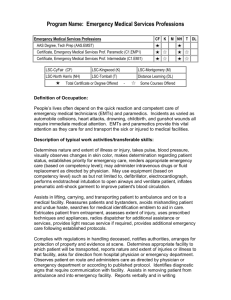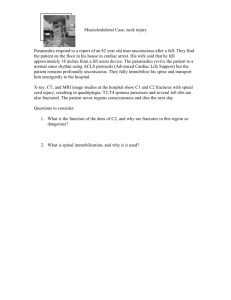Emergency Medical Technician and Paramedic
advertisement

Emergency Medical Technician and Paramedic Job Category Healthcare Practitioners & Technical Job Description People's lives often depend on the quick reaction and competent care of emergency medical technicians (EMTs) and paramedics, EMTs with additional advanced training to perform more difficult pre-hospital medical procedures. Incidents as varied as automobile accidents, heart attacks, drownings, childbirth, and gunshot wounds all require immediate medical attention. EMTs and paramedics provide this vital attention as they care for and transport the sick or injured to a medical facility. Depending on the nature of the emergency, EMTs and paramedics typically are dispatched to the scene by a 911 operator and often work with police and fire department personnel. Once they arrive, they determine the nature and extent of the patient's condition while trying to ascertain whether the patient has preexisting medical problems. Following strict rules and guidelines, they give appropriate emergency care and, when necessary, transport the patient. Some paramedics are trained to treat patients with minor injuries on the scene of an accident or at their home without transporting them to a medical facility. Emergency treatments for more complicated problems are carried out under the direction of medical doctors by radio preceding or during transport. EMTs and paramedics may use special equipment such as backboards to immobilize patients before placing them on stretchers and securing them in the ambulance for transport to a medical facility. Usually, one EMT or paramedic drives while the other monitors the patient's vital signs and gives additional care as needed. Some EMTs work as part of the flight crew of helicopters that transport critically ill or injured patients to hospital trauma centers. At the medical facility, EMTs and paramedics help transfer patients to the emergency department, report their observations and actions to staff, and may provide additional emergency treatment. After each run, EMTs and paramedics replace used supplies and check equipment. If a transported patient had a contagious disease, EMTs and paramedics decontaminate the interior of the ambulance and report cases to the proper authorities. Beyond these general duties, the specific responsibilities of EMTs and paramedics depend on their level of qualification and training. To determine this, the National Registry of Emergency Medical Technicians (NREMT) registers emergency medical service (EMS) providers at four levels: First Responder, EMT-Basic, EMT-Intermediate, and EMTParamedic. Some states, however, do their own certification and use numeric ratings from 1 to 4 to distinguish levels of proficiency. Emergency Medical Technician and Paramedic The lowest level -- First Responders -- are trained to provide basic emergency medical care because they tend to be the first persons to arrive at the scene of an incident. Many firefighters, police officers, and other emergency workers have this level of training. The EMT-Basic, also known as EMT-1, represents the first component of the emergency medical technician system. An EMT-1 is trained to care for patients on accident scenes and on transport by ambulance to the hospital under medical direction. The EMT-1 has the emergency skills to assess a patient's condition and manage respiratory, cardiac, and trauma emergencies. The EMT-Intermediate (EMT-2 and EMT-3) has more advanced training that allows administration of intravenous fluids, use of manual defibrillators to give lifesaving shocks to a stopped heart, and use of advanced airway techniques and equipment to assist patients experiencing respiratory emergencies. EMT-Paramedics (EMT-4) provide the most extensive pre-hospital care. In addition to the procedures already described, paramedics may administer drugs orally and intravenously, interpret electrocardiograms (EKGs), perform endotracheal intubations, and use monitors and other complex equipment. Emergency Medical Technician and Paramedic Working Conditions EMTs and paramedics work both indoors and outdoors, in all types of weather. They are required to do considerable kneeling, bending, and heavy lifting. These workers risk noise-induced hearing loss from sirens and back injuries from lifting patients. In addition, EMTs and paramedics may be exposed to diseases such as Hepatitis-B and AIDS, as well as violence from drug overdose victims or mentally unstable patients. The work is not only physically strenuous, but also stressful, involving life-or-death situations and suffering patients. Nonetheless, many people find the work exciting and challenging and enjoy the opportunity to help others. EMTs and paramedics employed by fire departments work about 50 hours a week. Those employed by hospitals frequently work between 45 and 60 hours a week, and those in private ambulance services, between 45 and 50 hours. Some of these workers, especially those in police and fire departments, are on call for extended periods. Because emergency services function 24 hours a day, EMTs and paramedics have irregular working hours that add to job stress. EMTs and paramedics should be emotionally stable, have good dexterity, agility, and physical coordination, and be able to lift and carry heavy loads. They also need good eyesight (corrective lenses may be used) with accurate color vision. Earnings of EMTs and paramedics depend on the employment setting and geographic location as well as the individual’s training and experience. Emergency Medical Technician and Paramedic Salary Range Median annual earnings of EMTs and paramedics were $29,300 in 2008. The middle 50 percent earned between $23,200 and $38,000. The lowest 10 percent earned less than $18,900, and the highest 10 percent earned more than $49,400. Those in emergency medical services who are part of fire or police departments receive the same benefits as firefighters or police officers. For example, many are covered by pension plans that provide retirement at half pay after 20 or 25 years of service or if the worker is disabled in the line of duty. Emergency Medical Technician and Paramedic Education Required Generally, a high school diploma is required to enter a training program to become an EMT or paramedic. Workers must complete a formal training and certification process. Training is offered at progressive levels: EMT-Basic, also known as EMT-1; EMT-Intermediate, or EMT-2 and EMT-3; and EMTparamedic, or EMT-4. The EMT-Basic represents the first level of skills required to work in the emergency medical system. Coursework typically emphasizes emergency skills such as managing respiratory, trauma, and cardiac emergencies and patient assessment. Formal courses are often combined with time in an emergency room or ambulance. The program also provides instruction and practice in dealing with bleeding, fractures, airway obstruction, cardiac arrest, and emergency childbirth. Students learn to use and maintain common emergency equipment, such as backboards, suction devices, splints, oxygen delivery systems, and stretchers. EMT-Intermediate training requirements vary from state to state. Applicants can opt to receive training in EMT-Shock Trauma, where the caregiver learns to start intravenous fluids and give certain medications, or in EMT-Cardiac, which includes learning heart rhythms and administering advanced medications. Training commonly includes 35 to 55 hours of additional instruction beyond EMT-Basic coursework and covers patient assessment, as well as the use of advanced airway devices and intravenous fluids. The most advanced level of training for this occupation is EMTParamedic. At this level, the caregiver receives additional training in body function and more advanced skills. The Paramedic Technology program usually lasts up to 2 years and results in an associate degree in applied science. Such education prepares the graduate to take the National Registry of Emergency Medical Technicians (NREMT) examination and become certified as an EMT-Paramedic. Extensive related coursework and clinical and field experience is required. Due to the longer training requirement, almost all EMT-Paramedics are in paid positions. Refresher courses and continuing education are available for EMTs and paramedics at all levels. Advancement beyond the EMT-Paramedic level usually means leaving fieldwork. An EMT-Paramedic can become a supervisor, operations manager, administrative director, or executive director of emergency services. Some EMTs and paramedics become instructors, dispatchers, or physician assistants, while others move into sales or marketing of emergency medical equipment. A number of people become EMTs and paramedics to assess their interest in healthcare and then decide to return to school and become registered nurses, physicians, or other health workers. Emergency Medical Technician and Paramedic Recommended High School Courses Biology, Mathematics, English, Health Postsecondary Instructional Programs Therapy and Counseling, Biology, Medicine and Dentistry, Telecommunications Certification and Licensing Formal training and certification is needed to become an EMT or paramedic. All 50 states possess a certification procedure. In most states and the District of Columbia, registration with the NREMT is required at some or all levels of certification. Other States administer their own certification examination or provide the option of taking the NRMET examination. To maintain certification, EMTs and paramedics must reregister, usually every 2 years. In order to re-register, an individual must be working as an EMT or paramedic and meet a continuing education requirement. Graduates of approved EMT basic training programs who pass a written and practical examination administered by the state certifying agency or the NREMT earn the title of Registered EMT-Basic. The course also is a prerequisite for EMT-Intermediate and EMTParamedic training. Prerequisites for taking the EMT-Intermediate examination include registration as an EMT-Basic, required classroom work, and a specified amount of clinical experience. The Paramedic Technology program usually lasts up to 2 years and results in an associate degree in applied science. Such education prepares the graduate to take the NREMT examination and become certified as an EMT-Paramedic. Extensive related coursework and clinical and field experience is required. Due to the longer training requirement, almost all EMT-Paramedics are in paid positions. Refresher courses and continuing education are available for EMTs and paramedics at all levels. Emergency Medical Technician and Paramedic Skills, Abilities, & Interests Interest Area Social Involves working and communicating with, helping, and teaching people. Work Values Achievement Social Service Ability Utilization Co-workers Skills Critical Thinking Use logic and analysis to identify the strengths and weaknesses of different approaches. Active Listening Listen to what other people are saying and ask questions as appropriate. Determine the kind of tools and equipment Equipment needed to do a job. Selection Adjust actions in relation to others' actions. Coordination Talk to others to effectively convey Speaking information. Abilities Oral Expression Deductive Reasoning Problem Sensitivity Inductive Reasoning Oral Comprehension Related Jobs Get a feeling of accomplishment. Do things for other people. Make use of individual abilities. Have co-workers who are easy to get along with. Able to convey information and ideas through speech in ways that others will understand. Able to apply general rules to specific problems to come up with logical answers, including deciding whether an answer makes sense. Able to tell when something is wrong or likely to go wrong. This doesn't involve solving the problem, just recognizing that there is a problem. Able to combine separate pieces of information, or specific answers to problems, to form general rules or conclusions. This includes coming up with a logical explanation for why seemingly unrelated events occur together. Able to listen to and understand information and ideas presented through spoken words and sentences. Physician Assistant, Ambulance Driver, Nurse, Registered, Dentist, Aide, Nursing, Orderlies and Attendants, Therapist, Radiation, Chiropractor Emergency Medical Technician and Paramedic Job Outlook EMTs and paramedics held about 210,000 jobs in 2008. Most career EMTs and paramedics work in metropolitan areas. There are many more volunteer EMTs and paramedics, especially in smaller cities, towns, and rural areas. These individuals volunteer for fire departments, emergency medical services (EMS), or hospitals, and may respond to only a few calls for service per month or may answer the majority of calls, especially in smaller communities. EMTs and paramedics work closely with firefighters, who often are certified as EMTs as well and act as first responders. Full-time and part-time paid EMTs and paramedics were employed in a number of industries. About 4 out of 10 worked as employees of private ambulance services. About 3 out of 10 worked in local government for fire departments, public ambulance services, and EMS. Another 2 out 10 were found in hospitals, working full time within the medical facility or responded to calls in ambulances or helicopters to transport critically ill or injured patients. The remainder worked in various industries providing emergency services. Employment of EMTs and paramedics is expected to grow faster than the average for all occupations through 2018. Population growth and urbanization will increase the demand for full-time paid EMTs and paramedics rather than for volunteers. In addition, a large segment of the population -- the aging baby boomers -- will further spur demand for EMT services, as they become more likely to have medical emergencies. There will still be demand for part-time, volunteer EMTs and paramedics in rural areas and smaller metropolitan areas. In addition to job growth, openings will occur because of replacement needs; some workers leave because of stressful working conditions, limited advancement potential, and the modest pay and benefits in the private sector. Most opportunities for EMTs and paramedics are expected to arise in hospitals and private ambulance services. Competition will be greater for jobs in local government, including fire, police, and independent third service rescue squad departments, where salaries and benefits tend to be slightly better. Opportunities will be best for those who have advanced certifications, such as EMT-Intermediate and EMTParamedic, as clients and patients demand higher levels of care before arriving at the hospital. Emergency Medical Technician and Paramedic http://science.education.nih.gov/LifeWorks.nsf/Alphabetical+List/Technician,+Emergency+Medical,+and+Par amedic?OpenDocument&ShowTab=All&


